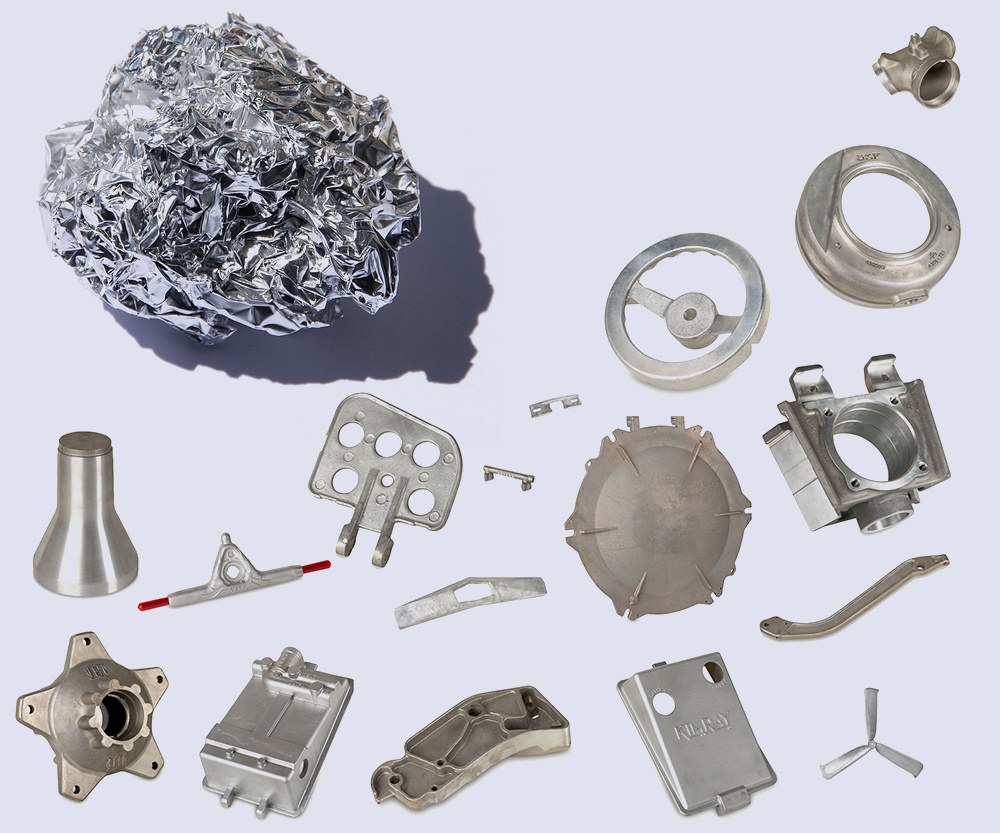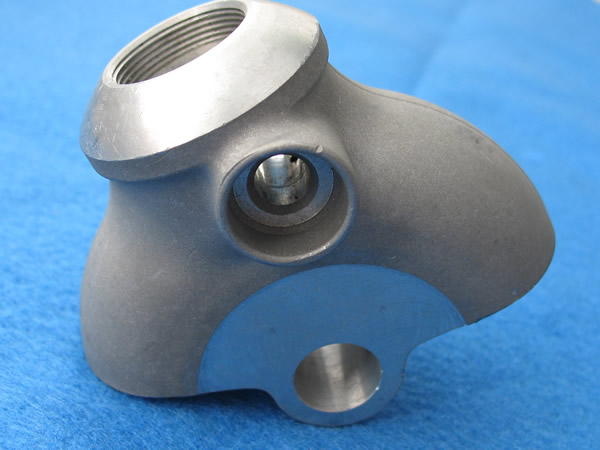A comprehensive overview to Aluminum Casting processes
Whatever You Required to Understand About the Uses and Benefits of Aluminum Castings
Aluminum castings play a crucial duty throughout various sectors, using unique homes that improve product efficiency. Their light-weight nature and strength make them excellent for applications in vehicle and aerospace fields. In addition, the flexibility of casting methods permits detailed styles and limited resistances. As the demand for lasting solutions climbs, comprehending the benefits and applications of aluminum castings ends up being progressively essential. What particular advantages do they offer over various other products?
Introduction of Aluminum Casting Processes
Aluminum casting processes encompass a range of techniques used to form molten aluminum into desired types. These methods consist of sand spreading, pass away spreading, and financial investment spreading, each offering distinct benefits depending on the application (Aluminum Casting). Sand spreading includes developing a mold from sand, permitting elaborate styles and huge elements, while die casting makes use of high stress to infuse liquified aluminum right into steel molds, guaranteeing precision and smooth finishes. Financial investment casting, additionally referred to as lost-wax casting, creates intricate shapes with exceptional dimensional accuracy, making it suitable for in-depth parts
These procedures are characterized by their capability to produce lightweight, sturdy parts that display superb rust resistance. The flexibility of aluminum enables personalization in different sectors, from automotive to aerospace. Furthermore, the capability to recycle aluminum enhances the sustainability of these casting procedures, minimizing environmental influence while preserving product stability. Comprehending these methods is essential for optimizing manufacturing effectiveness and attaining high-grade aluminum castings.
Key Applications of Aluminum Castings
Aluminum castings play a necessary function across different sectors, especially in automobile, aerospace, and consumer electronics. In the auto industry, they contribute to light-weight frameworks that enhance gas effectiveness. Similarly, aerospace elements profit from aluminum's strength-to-weight proportion, while consumer electronic devices take advantage of its adaptability for efficient manufacturing.
Automotive Sector Applications
As the automobile sector remains to progress, suppliers significantly depend on aluminum castings for their light-weight yet long lasting buildings. These castings play a vital duty in boosting vehicle performance, gas performance, and general safety and security. Trick applications include engine blocks, transmission housings, and structural elements, which take advantage of aluminum's excellent strength-to-weight ratio. In addition, aluminum castings promote complicated geometries, enabling cutting-edge styles that enhance the rules of aerodynamics and decrease drag. The deterioration resistance of aluminum also adds to long life, minimizing upkeep prices for both manufacturers and consumers. As electric automobiles gain popularity, aluminum castings are vital for battery units and other components, further solidifying their significance in the future of automotive manufacturing.
Aerospace Element Production
In the aerospace sector, aluminum castings are important to the manufacturing of light-weight, high-performance parts. These castings are essential for manufacturing components such as engine housings, architectural structures, and touchdown gear parts, where weight decrease is important for fuel performance and total performance. The outstanding strength-to-weight proportion of aluminum permits the advancement of complex geometries that improve aerodynamics. Furthermore, aluminum's resistance to corrosion adds to the longevity and integrity of aerospace components, making certain safety and security in flight procedures. The spreading process also enables exact tolerances, which is essential in meeting stringent aerospace market requirements. In general, aluminum castings play a crucial function beforehand aerospace modern technology while sustaining the sector's press for lasting methods.
Customer Electronic Devices Production
Using aluminum castings in consumer electronics production has ended up being progressively substantial because of their light-weight and durable homes. Suppliers leverage these castings to produce components for numerous tools, including smart devices, laptop computers, and video gaming consoles. Aluminum's superb thermal conductivity additionally assists in warmth dissipation, enhancing gadget efficiency and durability. The versatility of aluminum enables for intricate layouts and complex geometries, making it possible for smooth and modern aesthetics that appeal to customers. In addition, aluminum castings can be easily recycled, lining up with the expanding demand for lasting manufacturing methods. As modern technology advances, the function of aluminum castings in establishing innovative and reliable consumer electronic devices is expected to increase, making them a staple in the sector.

Advantages of Using Aluminum Castings
While various products are offered for casting, aluminum sticks out due to its one-of-a-kind mix of light-weight properties, strength, and corrosion resistance. The reduced thickness of aluminum makes it an optimal option for applications where weight reduction is essential, such as in the automotive and aerospace sectors. Its superb strength-to-weight ratio enables makers check my source to produce sturdy components without including too much weight.
Additionally, aluminum castings can be created with complex layouts and tight tolerances, allowing intricate geometries that are difficult to accomplish with other materials. The flexibility of aluminum permits for various casting techniques, including sand, pass away, and financial investment casting, dealing with diverse manufacturing requirements. Furthermore, aluminum's convenience of machining and finishing improves its charm, helping with the creation of top notch surface area coatings. Overall, the advantages of using aluminum castings add to boosted efficiency and efficiency in numerous applications across different industries.
Rust Resistance in Aluminum Castings

All-natural Oxide Layer
A natural oxide layer forms on the surface of aluminum castings, giving a crucial barrier against ecological elements that can result in damage. This thin, protective movie is an outcome of the aluminum's response with oxygen in the air, effectively securing the underlying metal from moisture, chemicals, and toxins. Because of this, aluminum castings exhibit impressive corrosion resistance, which improves their longevity and durability in numerous applications. The oxide layer is not only valuable for protection yet also adds to visual top qualities, as it can develop a matte surface that numerous industries like. Additionally, this all-natural procedure minimizes the demand for additional layers, making aluminum castings a cost-efficient option for manufacturers seeking dependable, durable materials.
Alloy Variations Impact
The make-up of aluminum alloys considerably influences their rust resistance residential or commercial properties in castings. Different alloy variations, such as 1xxx, 2xxx, and 6xxx series, display distinct degrees of sensitivity to rust. 1xxx alloys, mostly composed of pure aluminum, deal excellent deterioration resistance due to their high pureness. In comparison, 2xxx alloys, which include copper, might experience significant corrosion when revealed to extreme settings. Meanwhile, 6xxx alloys, including magnesium and silicon, strike an equilibrium between strength and resistance. The presence of alloying elements can enhance or lessen safety oxide layers, ultimately influencing longevity and efficiency. Comprehending these variants is necessary for selecting the appropriate alloy for particular applications where corrosion resistance is crucial.
Design Adaptability and Modification
Various materials exist for casting applications, aluminum stands out due to its exceptional style adaptability and possibility for personalization. This convenience enables designers and designers to create intricate forms and kinds that fulfill specific practical demands. Aluminum Casting. The low thickness of aluminum enables lightweight layouts, which is specifically valuable in sectors such as vehicle and aerospace, where weight reduction is essential
Aluminum castings can be tailored to different requirements, including wall surface density, surface coating, and dimensional resistances. This versatility not just enhances the aesthetic appeal but additionally improves the performance of the final item. Furthermore, advanced methods such as 3D printing and computer-aided design (CAD) more help with the customization procedure, enabling fast prototyping and lowering preparations. Subsequently, aluminum castings can successfully satisfy the diverse demands of various markets while supplying suppliers the capacity to introduce and respond promptly to market demands.
Comparison With Other Casting Materials
While different casting products each have their one-of-a-kind benefits, aluminum constantly demonstrates exceptional buildings that make it a preferred selection in several applications. Compared to iron and steel, aluminum is considerably lighter, which reduces the total weight of ended up items, improving gas efficiency in auto and aerospace sectors. Aluminum uses exceptional rust resistance, needing less upkeep over time contrasted to materials like iron, which can rust.
When juxtaposed with plastics, aluminum's strength and sturdiness go beyond many artificial choices, making it appropriate for demanding settings. Additionally, aluminum's thermal and electrical conductivity is incredibly greater than a lot of various other steels, making it ideal for applications needing efficient warm dissipation or his explanation electric parts.

Future Fads in Aluminum Casting Technology
Developments in aluminum casting innovation are established to redefine its applications throughout various sectors. Developments in automation and robotics are improving manufacturing processes, boosting performance and precision. The combination read here of expert system and equipment learning makes it possible for real-time surveillance and predictive maintenance, decreasing downtime and boosting top quality control.
Furthermore, the growth of advanced alloys is expanding the efficiency capabilities of aluminum castings, making them suitable for even more requiring applications, especially in automotive and aerospace sectors. Lasting practices are additionally gaining traction, with raised focus on recycling aluminum and decreasing carbon footprints during manufacturing.
Additive production techniques, such as 3D printing, are being checked out to produce complex geometries that standard methods can not attain, permitting higher style flexibility. These fads indicate a future where aluminum casting will not only meet yet surpass sector expectations, driving innovation and sustainability in production.
Regularly Asked Inquiries
How Are Aluminum Castings Recycled After Usage?
Aluminum castings are generally gathered, cleaned, and processed in reusing centers. The material is melted down, improved, and after that reformed right into brand-new items, thereby conserving sources and minimizing ecological effect while maintaining aluminum's preferable residential properties.
What Are the Common Expenses Related To Aluminum Castings?
The common costs linked with aluminum castings vary based on factors such as intricacy, volume, and material specifications. Typically, costs range from a few dollars per extra pound to considerably greater quantities for complex styles and huge amounts.
Exactly How Do Aluminum Castings Contrast in Weight to Steel Castings?
Aluminum castings weigh considerably less than steel castings, normally around one-third the weight (Aluminum Casting). This lowered mass enables for simpler handling, transport, and application in various markets, adding to boosted performance in layout and manufacturing processes
What Industries Mainly Depend On Aluminum Castings?
Different sectors greatly depend on aluminum castings, including auto, aerospace, electronics, and durable goods. Their light-weight nature, corrosion resistance, and adaptability make them important for making components in these industries, boosting efficiency and efficiency.
Exist Any Type Of Health Dangers Connected With Aluminum Casting Processes?
Wellness threats linked with aluminum spreading processes include direct exposure to fumes, dirt, and chemicals, which can result in respiratory problems and skin irritation. Proper safety and security actions and devices are vital to minimize these possible threats in the workplace.